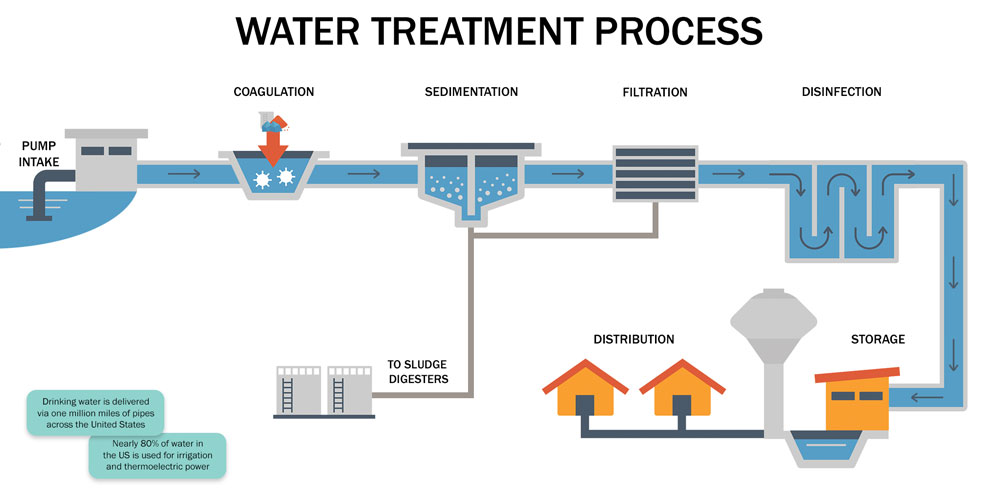Getting The Water Treatment Systems For Well Water To Work
Table of ContentsIndicators on Water Treatment Systems For Well Water You Should KnowIndicators on Water Treatment Systems For Well Water You Should KnowGet This Report about Water Treatment Systems For Well WaterThe Best Guide To Water Treatment Systems For Well WaterThe Buzz on Water Treatment Systems For Well WaterExamine This Report on Water Treatment Systems For Well Water
(There is a chlorination step at the end of the therapy process, which is regular in many water therapy plants). 3 Coagulation as well as flocculation, After aeration, coagulation takes area, to remove the great particles (much less than 1 m in dimension) that are suspended in the water.Below the water is gently mixed by paddles in a flocculation container (Figure 5. 5) as well as the flocs enter contact with each other to create larger flocs. The flocculation basin commonly has a number of areas with decreasing mixing rates as the water advancements via the container (Number 5.
5 Filtering, Filtration is the process where solids are separated from a fluid. In water therapy, the solids that are not divided out in the sedimentation container are eliminated by passing the water via beds of sand and also gravel.
More About Water Treatment Systems For Well Water
7), with a circulation price of 48 cubic metres per square metre of filter surface per hr (this is composed as 48 m3 m2 h1) are often utilized. When the filters have lots of entraped solids, they are backwashed. In this procedure, tidy water and air are pumped in reverse up the filter to remove the entraped impurities, and also the water lugging the dirt (referred to as backwash) is pumped right into the sewerage system, if there is one.
6 Chlorination, After sedimentation, the water is decontaminated to get rid of any staying pathogenic micro-organisms. The most commonly made use of disinfectant (the chemical made use of for disinfection) is chlorine, in the kind of a fluid (such as sodium hypochlorite, Na, OCl) or a gas.
The quantity of chlorine left after this is called recurring chlorine. This stays in the water all the means with the circulation system, safeguarding it from any kind of micro-organisms that may enter it, till the water reaches the customers. Globe Health Company Guidelines (WHO, 2003) recommend a maximum recurring chlorine of 5 mg l1 of water.
Little Known Questions About Water Treatment Systems For Well Water.
5 mg l1 of water after thirty minutes' get in touch with time (WHO, n. d.). There are various other means of disinfecting water (e. g. by utilizing the gas ozone, or ultraviolet radiation) yet these do not protect it from microbial contamination after it has left the water treatment plant. Complying with disinfection the cured water is pumped into the distribution system.
7 Auxiliary therapy, Additional treatment may in some cases be needed for the benefit of the population. One such circumstances is the fluoridation of water, where fluoride is contributed to water - water treatment systems for well water. It has been stated by the World Health Organization that 'fluoridation of water materials, where possible, is one of the most reliable public wellness measure for the avoidance of oral degeneration' (THAT, 2001).
On the various other hand, as you found out in Research Session 2, find more information in the Break Valley of Ethiopia, the water sources consist of a higher concentration of fluoride than is desirable. Tekle-Haimanot et al. (1995) discovered that the level of fluoride in drinking water from deep wells there varied from 1. 5 to 36 mg l1.
Water Treatment Systems For Well Water for Beginners
5 mg l1. What does excess fluoride in the water result in? As pointed out in Research study Session 2, in children it can trigger stippling of teeth and also extended exposure can cause skeletal fluorosis and also crippling. In such high-fluoride locations, removal or decrease of fluoride (described defluoridation) is important. The most basic method of doing this is to blend the high-fluoride water with water that has no (or very little) fluoride so that the last blend is risk-free.

In the last it is included to the incoming sewage, where it can assist negotiation of solids. The backwash from the sand filter is discharged into the drain or gone back to the river after negotiation of solids. Product packaging waste such as chemical drums can be returned to the provider for reuse.
Excitement About Water Treatment Systems For Well Water
5.4 Sustainability as well as strength in water therapy, In Research Session 4 you review some aspects that can influence the sustainability of a water source. For example, decreasing soil erosion by growing trees and also maintaining plants can decrease the quantity of silt that accumulates in a reservoir and lengthen its life.
Complicated systems ought to be avoided and also anywhere feasible in your area offered products ought to be used. For instance, if a coagulant is needed, the one that can be purchased in-country will certainly be better to one that has actually to be imported. Water treatment plants eat power, and if this power can be provided through sustainable resources (such as solar or wind) it will certainly maintain operating expenses down and also improve sustainability.
It can be challenging to get spare parts, so there should be strategies in area for procurement of substitutes. (These and other administration issues are the subject of the following research study session.) One more crucial factor in sustainability is an efficient maintenance system, which requires planning as well as, importantly, needs trained and determined staff.
Getting My Water Treatment Systems For Well Water To Work
